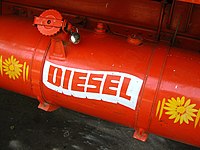
Photo from wikipedia
The thermal behavior of biodiesel and a comparison with a petroleum diesel combustion process was investigated via thermogravimetric analysis. The investigation was carried out under atmospheric conditions of pure air… Click to show full abstract
The thermal behavior of biodiesel and a comparison with a petroleum diesel combustion process was investigated via thermogravimetric analysis. The investigation was carried out under atmospheric conditions of pure air flow at four different heating rates, reaching a temperature of 700 °C. Beyond the initiation (a fraction of mass loss) stage of the thermograph, the diesel exhibited only one mass loss event, whereas the biodiesel was characterized with two mass loss events. The ignition and burnout temperatures are essential properties of fuel combustion used in their industrial application, and they were evaluated using numerous methods at every heating value. The kinetic parameters were also calculated using the Kissinger method. The values obtained for the main mass loss event I, devolatilization, were 98.8 and 63.4 kJ mol−1, respectively, for the biodiesel and diesel. Additionally, the thermodynamic parameters were calculated including the enthalpy, Gibbs free energy and entropy and found to be 94.3 kJ mol−1, 158 kJ mol−1 and − 0.116 kJ mol−1 for the biodiesel, compared to 59.2 kJ mol−1, 150.5 kJ mol−1 and − 0.117 kJ mol−1 for the diesel, respectively. Results indicate better reactivity in favor of the petroleum diesel. Hence, utilizing biodiesel at 100% for utility burners and internal combustion engine may require some additives to compensate the change and the measured lower heating value (~ ≤ 5%). Therefore, blending has been the simplest practical approach.
Journal Title: Journal of Thermal Analysis and Calorimetry
Year Published: 2018
Link to full text (if available)
Share on Social Media: Sign Up to like & get
recommendations!